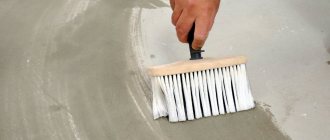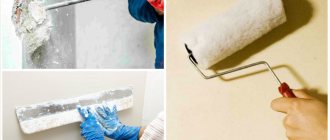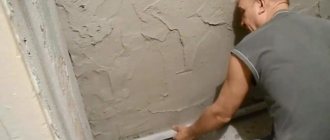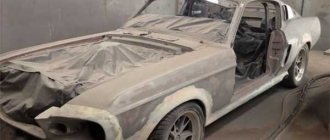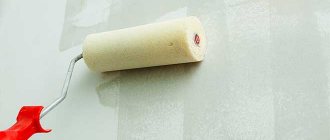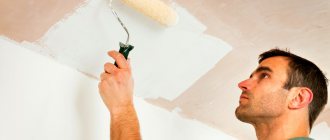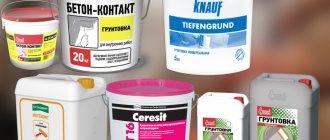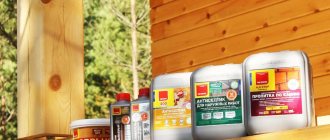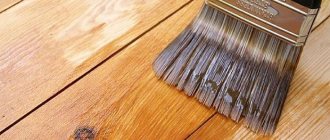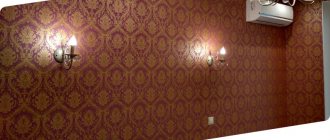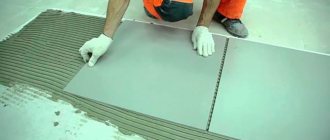From the author: Hello, dear readers. Kitchen and bathroom renovations are not complete without tiling. Which is quite logical, because it is a multifunctional and visually attractive material. It’s great if you have a trusted technician to whom you can entrust repair work and listen to advice. What if there is no such thing in your environment? Today we will conduct a step-by-step debriefing with recommendations from an experienced craftsman and answer a pressing and frequently asked question: is it necessary to prime the walls before laying tiles, and how to lay them correctly.
Why is a primer needed?
A primer is necessary before laying tiles primarily in order to increase the stability of the tiles, which increases their service life.
There are a large number of varieties of the mixture, some of which additionally protect the material from corrosion, in case the tiles are laid on metal.
Also, the primer may have antiseptic properties, so there is no doubt about the need to prime the surface before laying the tiles.
Required Tools
For dismantling, plastering and other preparatory work, you need to prepare tools that may be useful at a certain stage of the work.
- Hammer.
- Bulgarian.
- Building level.
- Tape measure and pencil.
- Spatula and trowel.
- Sandpaper.
- Container for mixing the solution.
- Chisel.
- Lighthouses.
- Protective clothing.
There are many types of spatulas and trowels that are used for plastering walls. It is important to remember that laying tiles is a fairly simple process, but preparing walls can be a lengthy and more labor-intensive process.
The durability and appearance of the cladding, which can last for decades, directly depends on proper preparation. Each stage of preparation is incredibly important, but it guarantees a positive result and is the key to successful and high-quality repairs.
How to make the right choice
As mentioned above, today there are a large number of soil mixtures, each of them has a unique composition and is used in certain cases.
To make the right choice among the variety of options, you need to follow several rules.
- First of all, you need to pay attention to the packaging. Cheap types of primers will require re-application, i.e. before laying the tiles you need to apply the primer in 2 layers. As a rule, this technology is not very reliable and is typical only for cheap types of soil. It is recommended to overpay a little and purchase a high-quality mixture that only needs to be applied once.
- It is necessary to take into account the characteristics of the material on which the primer is supposed to be applied. The recommended compositions for wood, metal and concrete are significantly different, you need to take this into account when choosing the appropriate option.
Preparing glue for laying porcelain tiles
To get an excellent result and avoid problems with porcelain tiles in the future, remember: do not experiment with the proportions of water and dry adhesive mixture. Strictly follow the recommendations provided by the adhesive manufacturer on the packaging. Maintain exactly the right time and follow the order of necessary operations.
Keep in mind: the dry mixture is poured into the water, and not vice versa. It is necessary to continuously stir the mixture until a homogeneous plastic mass is obtained. There shouldn't be any lumps in it
It is important to remember that the finished glue retains its properties for only a few hours. Therefore, it is very important to correctly calculate your strength
Types of primer
Let's look at the main types of soil mixtures available for sale.
Acrylic
Today this is the most popular type of primer. This is due to the fact that its composition is universal and can be used to create a suitable soil mixture for virtually any material.
In addition, the cost of such a primer is relatively low, which makes it affordable and also very reliable.
Alkyd
A variety of primers based on this component element are as durable as possible. The compositions are ideal for application to glass, metal and tiles. For other materials, this variety is not the best option when choosing.
Based on cement and gypsum
Such compositions also have lime as one of the main components. Perfect for concrete or brick surfaces covered with a layer of plaster.
This is much more convenient than preparing plasterboard for laying tiles.
- These are just the main directions intended for certain materials.
- There are also subspecies based on them, which have deep penetration into materials, providing maximum adhesion to the tiles, also with antiseptic properties; they must be selected as carefully as possible.
Primer for materials
When working with each material, you need to take into account its characteristics.
- So, for example, if it is necessary to prime drywall, you must first thoroughly putty it.
- Please note that it is recommended to select waterproof materials so as not to deform the drywall.
- Only after this can a primer be applied that is suitable in composition for this material.
If you need to lay tiles on plywood, you must first carefully prepare it. This is due to the fact that it has a porous surface, so you need to first apply an adhesive mixture, which will allow you to properly apply the primer and tiles on it.
When working with marble and other similar materials, you should give preference not to strengthening compounds, but to primers containing sand. They will allow you to achieve greater adhesion to the tiles, which will have a positive effect on the reliability of the fastening.
Do I need to prime walls and floors and why?
Experts don’t really understand why a question arises, the answer to which is obvious to them. When it comes to most types of surfaces, priming the wall before laying tiles is a mandatory process. Although there are always exceptions to the rules. And in this case it concerns concrete. It does not require priming the walls under the tiles.
However, walls that have a porous and loose structure must be primed for tiles before installation.
Why is the procedure performed:
- Priming makes surfaces stronger. The primer solution, which penetrates into the porous structure of the upper thickness of the wall, is considered a binding material that significantly strengthens the base one. This helps protect the primed surface of the wall from destruction due to the pressure exerted on it (dynamic or static);
- For economic reasons, when carrying out further repairs, the consumption of finishing materials (not only ceramic tiles, but also paint, wallpaper, plaster, etc.) is significantly reduced. The primer solution, filling the upper pores of the wall material, forms a thin and dense film on the surface. It is this film that comes into contact in the future with a certain type of facing material;
- To enhance the adhesive properties between the upper thickness of the wall and the applied material. It is noted that tile adhesive is most reliably attached to the primer, allowing for optimal adhesion of surfaces.
How to remove unnecessary things
If the primer accidentally gets on the front surface of the tile, there are several ways to correct the situation.
- First of all, you need to try regular warm water with soap and a sponge or rag.
- This method is only suitable if the primer has just been applied to the surface and has not yet had time to harden.
- It is worth considering that the composition hardens quite quickly, so you cannot hesitate.
If the composition has already dried, you can try to cover the stain with damp rags, this will soften the primer on the front side of the tile, and then carefully remove it with a rag and soapy warm water.
If the primer stain is already old, you cannot do without using special cleaning products for plumbing fixtures. Preference should be given to potent compounds, but without abrasive additives, because they can scratch the tiles. It is also recommended to try glass cleaners in the fight against stains of dried primer, they help a lot.
Primer Application Instructions
In order to apply the primer correctly, you must strictly follow the rules and recommendations provided by the manufacturers.
- It is also necessary to carefully prepare the material in advance; if it is metal or glass, it must first be degreased and cleaned of all contaminants.
- This will increase the adhesion between the material and the primer, which will also have a positive effect on the reliability of the laid tiles.
- It is also necessary to take into account the entire tile and the characteristics of the material on which it is laid. This should be taken into account in particular when covering walls indoors.
Tiles that are too heavy may simply fall off the wall if the physical characteristics of the materials are not taken into account and the adhesive composition is not selected correctly.
Water sockets for plumbing
Most often, when preparing the walls for tiles, the home craftsman forgets about installing cold water/hot water outlets. This can dramatically increase the cost of repairs, since a whole row of tiles will have to be dismantled. The required collection of tiles may be out of stock in the store or sold as a set.
The technology for laying pipes depends on their purpose and the method of leveling the walls:
- grooves are made in plaster, brick, concrete;
Laying pipes for water sockets in the walls. - when using gypsum plasterboard, communications are stretched between the false panel and the drywall, the socket is attached to the profile;
Installation of water sockets in drywall. - if the gypsum board is glued to the wall, the two previous methods are combined.
Holes are cut in plasterboard boxes where tees are installed, through which plumbing fixtures are connected to the sewer system.
We recommend reading: 7 best ways to hide pipes in the bathroom.
